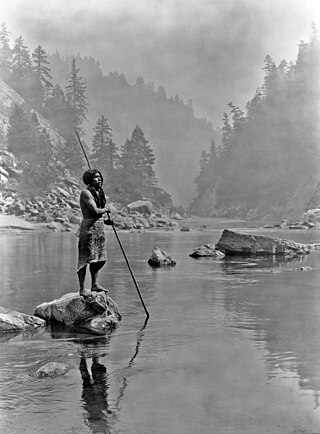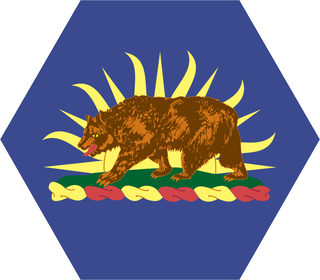Related Research Articles

The California Gold Rush (1848–1855) was a gold rush that began on January 24, 1848, when gold was found by James W. Marshall at Sutter's Mill in Coloma, California. The news of gold brought approximately 300,000 people to California from the rest of the United States and abroad. The sudden influx of gold into the money supply reinvigorated the American economy; the sudden population increase allowed California to go rapidly to statehood in the Compromise of 1850. The Gold Rush had severe effects on Native Californians and accelerated the Native American population's decline from disease, starvation and the California genocide.

Hubert Howe Bancroft was an American historian and ethnologist who wrote, published, and collected works concerning the western United States, Texas, California, Alaska, Mexico, Central America, and British Columbia.

Klamath County was a county of California from 1851 to 1874. During its existence, the county seat moved twice and ultimately portions of the territory it once had were carved up and added to nearby counties. It was formed from the northwestern portion of Trinity County, and originally included all of the northwestern part of the state, from the Mad River in the south to Oregon in the north, from the Pacific Ocean in the west to the middle of what is now Siskiyou County in the east. It is the only county in California to be disestablished.

Miguel Gregorio de la Luz Atenógenes Miramón y Tarelo, known as Miguel Miramón, was a Mexican conservative general who became president of Mexico at the age of twenty seven during the Reform War, serving between February 1859 and December 1860. He was the first Mexican president to be born after the Mexican War of Independence.
Forks of Salmon is an unincorporated community of Siskiyou County in northern California, USA. The town is situated at the confluence of the north and south forks of the Salmon River, hence its name. The ZIP Code is 96031. The community is inside area code 530.

Hupa are a Native American people of the Athabaskan-speaking ethnolinguistic group in northwestern California. Their endonym is Natinixwe, also spelled Natinook-wa, meaning "People of the Place Where the Trails Return". The Karuk name was Kishákeevar / Kishakeevra. The majority of the tribe is enrolled in the federally recognized Hoopa Valley Tribe.

The Battle of the Natividad took place on November 16, 1846, in the Salinas Valley, in present-day Monterey County, California, United States, during the California Campaign of the Mexican–American War, between United States organized California militia and loyalist Mexican militia.

The California Army National Guard is one of three components of the California National Guard, a reserve of the United States Army, and part of the National Guard of the United States. The California Army National Guard is composed of 18,450 soldiers. Nationwide, the Army National Guard comprises approximately one half of the US Army's available combat forces and approximately one third of its support organization. National coordination of various state National Guard units are maintained through the National Guard Bureau.
Zachariah "Zach" Montgomery was a publisher, lawyer, politician, and author, particularly known for his skills as an orator.
Higgins Point is a former mining camp in El Dorado County, California. It was located a half mile west of the center of Salmon Falls. The place was named for the first person to open a store there, an Australian named Higgins. Rich diggings of gold were discovered by Mormons at Higgins Point in 1849. Higgins Point was the first part of Salmon Falls to be laid out as a town, starting in 1853.

Snake Indians is a collective name given to the Northern Paiute, Bannock, and Shoshone Native American tribes.
Colonel Joseph S. Ruckle was a businessman who moved to Oregon in 1855.
Mokelumne City is a ghost town in San Joaquin County, California, United States. Mokelumne, established in 1850, was the second largest town in San Joaquin County until it was destroyed by the floods of 1862.

Sawyers Bar is an unincorporated community located on the North Fork Salmon River in unincorporated Siskiyou County, California, not to be confused with a Sawyers or Lawyers Bar in Del Norte County.

Charles Stewart Drew, also known as C.S. Drew, was a representative in the legislature of the Oregon Territory of the United States and quartermaster general of the territorial militia in the 1850s. During the American Civil War, he was a Union Army officer, serving in the 1st Oregon Cavalry regiment. He eventually reached the rank of lieutenant colonel. In 1864, he led an Army reconnaissance party into southeastern Oregon. The expedition, known as the Owyhee Reconnaissance, traveled through uncharted country from Fort Klamath to Fort Boise and back. Drew was the author of two historically important military reports; one documented Indian attacks on American settlers in the Oregon Territory and the other was his report of the Owyhee Reconnaissance.
Bestville is an unincorporated community in on the North Fork Salmon River in Siskiyou County, California, just downstream from Sawyers Bar. Bestville is located at 41.3007°N 123.1431°W.
Negro Flat was a placer gold mining camp on the Salmon River, now located in Siskiyou County, California. It was located originally in Trinity County, in 1850.
Black Bear is a populated place, originally a gold mining town in Klamath County, now in unincorporated Siskiyou County, California.

Nathaniel Holly Gates, also known as Colonel Gates for most of his life, (1811–1889) was an American pioneer lawyer and Oregon state legislator. He was an active Democrat throughout his life. He served four terms in Oregon's territorial legislature. This included one term as Speaker of the Oregon House of Representatives during the 1858 legislative session. After Oregon became a state in 1859, he served one two-year term in the Oregon House of Representatives and one four-year term in the Oregon State Senate. Before immigrating to Oregon, Gates lived and worked as a lawyer in Ohio and Iowa. After moving to Oregon, he settled in The Dalles and opened a law practice there. He helped develop that community and served as the city's mayor five times in non-consecutive terms.
References
- ↑ Hubert Howe Bancroft, History of California, Vol. VI, 1848-1859, The History company, San Francisco, 1888, p.370
- ↑ Theodore Henry Hittell, History of California, Volume 3, N. J. Stone, San Francisco, 1897, p.140
- ↑ The Works of Hubert Howe Bancroft: Vol. XXIII History of California, vol VI, 1848-1859, The History Company, San Francisco, 1888, p. 370, Note.
- ↑ "New Diggings In Klamath County. — Mr. J. H. Stanchfield, a trader on the South Fork of Salmon, arrived in town last evening, and from him we learn that new and rich diggings have been struck on a small stream, called Nordheimer's Creek, a tributary of the main Salmon, having its junction at Gullion's Bar." New Diggings In Klamath County, Daily Alta California, Volume 10, Number 210, 2 August 1858, p.1, col.7
- ↑ John Ross Browne, REPORT OF J. ROSS BROWNE OF THE MINERAL RESOURCES OF THE STATES AND TERRITORIES WEST OF THE ROCKY MOUNTAINS, Government Printing Office, Washington, 1868, p.202]
- ↑ "Ghost Towns of California (F-J)". February 27, 2021.
41°17′48″N123°21′36″W / 41.29667°N 123.36000°W
